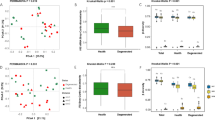Abstract
A fluctuating environment may facilitate co-existence of species, and high species richness may be important for maintaining ecosystem processes under changing environmental conditions. A positive relationship has been found between species richness and primary production in many experiments, and there is now an increasing interest whether similar relationships also apply to microorganisms and decomposition. Basidiomycete fungi are the primary decomposers of wood with the functional groups brown and white rot fungi, which differ with respect to decay strategy. In this study, 16 species of boreal wood decay fungi, 8 brown rot fungi and 8 white rot fungi, were assembled in artificial communities. The aims were to study species persistence, wood decomposition and metabolic efficiency in fungal communities of increasing levels of species richness under constant and fluctuating temperature regimes. Species persistence was generally low, but temperature fluctuations facilitated co-existence of species. Decomposition was highest at intermediate diversity levels under the fluctuating temperature regime. Metabolic efficiency, estimated as the amount of fungal mycelium formed per amount of degraded wood, decreased with increasing community complexity under the fluctuating temperature regime. Brown and white rot fungi differed in decomposition rates and metabolic efficiency, but no synergistic effects were found where the two functional groups were mixed. This study demonstrates how niche differentiation in a variable environment may act to maintain diversity and function. In our experiment, differences in functional responses to the varying temperature rather than resource partitioning between brown and white rot fungi had significant effects. Niche differentiation is likely to be particularly important in maintaining species diversity in communities of wood decaying fungi, which are known from previous studies to be characterised by intense competition, and where otherwise metabolically costly interactions lead to species exclusion and dominance by highly competitive species.

Similar content being viewed by others
References
Boddy L (2000) Interspecific combative interactions between wood-decaying basidiomycetes. FEMS Microbiol Ecol 31:185–194
Chesson P (2000) Mechanisms of maintenance of species diversity. Annu Rev Syst Ecol 31:343–366
Coates D (1983) Biology of intraspecific antagonism in wood-decaying fungi. PhD Thesis, University of Bath
Cooke RC, Rayner ADM (1984) Ecology of saprotrophic fungi. Longmans, London
Deacon JW (1997) Modern mycology, 3rd edn. Blackwell Science, Cambridge
Ekblad A, Näsholm T (1996) Determination of chitin in fungi and mycorrhizal roots by an improved HPLC analysis of glucosamine. Plant Soil 178:29–35
Ekblad A, Wallander H, Näsholm T (1998) Chitin and ergosterol combined to measure total and living fungal biomass in ectomycorrhizas. New Phytol 138:143–149
Gustafsson M (2002) Distribution and dispersal of wood-decaying fungi occurring on norway spruce logs. Acta Universitatis Agriculturae Sueciae, Silvestria 246, SLU Service/Repro, Uppsala
Hättenschwiler S, Tiunov AV, Scheu S (2005) Biodiversity and litter decomposition in terrestrial ecosystems. Annu Rev Ecol Evol Syst 36:191–218
Hector A et al (1999) Plant diversity and productivity experiments in European grasslands. Science 286:1123–1127
Holmer L, Stenlid J (1993) The importance of inoculum size for the competitive ability of wood decomposing fungi. FEMS Microbiol Ecol 12:169–176
Holmer L, Stenlid J (1997) Competitive hierarchies of wood decomposing basidiomycetes in artificial systems based on variable inoculum sizes. Oikos 79:77–84
Huston MA (1997) Hidden treatments in ecological experiments: re-evaluating the ecosystem function of biodiversity. Oecologia 110:449–460
Hutchinson GE (1961) The paradox of the plankton. Am Nat 95:137–145
Loreau M et al (2001) Ecology–biodiversity and ecosystem functioning: current knowledge and future challenges. Science 294:804–808
Mulder CPH, Uliassi DD, Doak DM (2001) Physical stress and diversity-productivity relationships: the role of positive interactions. Proc Natl Acad Sci USA 98:6704–6708
Naeem S, Li SB (1997) Biodiversity enhances ecosystem reliability. Nature 390:507–509
Naeem S, Thompson LJ, Lawler SP, Lawton JH, Woodfin RM (1994) Declining biodiversity can alter the performance of ecosystems. Nature 368:734–737
Niemelä T, Renvall P, Penttila R (1995) Interactions of fungi at late stages of wood decomposition. Ann Bot Fenn 32:141–152
Nobles MK (1965) Identification of cultures of wood-inhabiting hymenocetes. Can J Bot 43:1097–1139
Petchey OL, McPhearsson PT, Casey TM, Morin PJ (1999) Environmental warming alters food-web structure and ecosystem function. Nature 402:69–72
Rayner ADM, Boddy L (1988) Fungal decomposition of wood: its biology and ecology. Wiley, Chichester
Setälä H, McLean MA (2004) Decomposition rate of organic substrates in relation to the species diversity of soil saprophytic fungi. Oecologia 139:98–107
Swift MJ (1973) The estimation of mycelial biomass by determination of the hexosamine content of wood tissue decayed by fungi. Soil Biol Biochem 5:321–332
Tilman D, Wedin D, Knops D (1996) Productivity and sustainability influenced by biodiversity in grassland ecosystems. Nature 379:718–720
Tiunov AV, Scheu S (2005) Facilitative interactions rather than resource partitioning drive diversity-functioning relationships in laboratory fungal communities. Ecol Lett 8:618–625
Wells JM, Boddy L (2002) Interspecific carbon exchange and cost of interactions between basidiomycete mycelia in soil and wood. Funct Ecol 16:153–161
Wohl DL, Arora S, Gladstone JR (2004) Functional redundancy supports biodiversity and ecosystem function in a closed and constant environment. Ecology 85:1534–1540
Yachi S, Loreau M (1999) Biodiversity and ecosystem productivity in a fluctuating environment: The insurance hypothesis. Proc Natl Acad Sci USA 96:1463–1468
Acknowledgements
The authors are grateful for statistical advice from U. Olsson and G. Ekbohm and assistance with glucosamine measurements from T. Näsholm. Financial support from the Swedish Institute and the Oscar and Lilli Lamm Foundation and FORMAS is gratefully acknowledged. The experiment complies with the current laws of the country in which it was performed.
Author information
Authors and Affiliations
Corresponding author
Additional information
Communicated by Stephan Hattenschwiler
Electronic supplementary material
Rights and permissions
About this article
Cite this article
Toljander, Y.K., Lindahl, B.D., Holmer, L. et al. Environmental fluctuations facilitate species co-existence and increase decomposition in communities of wood decay fungi. Oecologia 148, 625–631 (2006). https://doi.org/10.1007/s00442-006-0406-3
Received:
Accepted:
Published:
Issue Date:
DOI: https://doi.org/10.1007/s00442-006-0406-3




